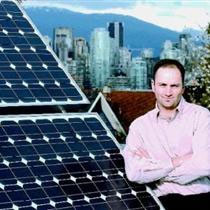Rain-soaked British Columbia may be one of the last places you would associate with solar power, but the sun is definitely rising here on this most sexy of the renewable-energy technologies.
 |
| Sustainable-energy advocate Scott Sinclair believes B.C. can realize the dream of zero emissions. CREDIT: Arlen Redekop, The Province |
The installation of rooftop solar-thermal systems for mitigating hot-water-heating costs are now paying for themselves in reasonable time frames and B.C. companies are working on ways to improve the efficiency of solar-electric or photovoltaic (PV) cells.
And this weekend, stakeholders participated in the B.C. Solar Summit, a smorgasbord of panels and workshops hosted by the B.C. Sustainable Energy Association (BCSEA) in Vancouver and Victoria to promote usage of the sun’s energy to reduce dependence on conventional electricity.
The conference had offerings for plumbing inspectors to policymakers to consumers.
“The beauty of B.C. is that we have this huge dam system that allows us to use hydro-electric power when we don’t have enough sunshine or wind or other forms of energy,” said Scott Sinclair, a BCSEA director. “It’s like a big storage system. The BCSEA believes we can become one of the first large regions of the world to have zero emissions.”
It may sound like pie-in-the-sky, but consider that it’s estimated the world’s energy requirements will triple this century.
With demand increasing and fossil fuel reserves dwindling, renewable energy sources will receive more and more attention — even here in B.C., where power is dirt cheap by global standards.
Actually, the sun’s power — through solar-thermal systems — has already made significant inroads in B.C. Numerous consumer and business installations use the sun’s energy to offset heating requirements for swimming pools and in-home hot-water tanks.
Vancouver International Airport has B.C.’s largest array — 100 solar panels that generate enough energy help to heat an average of 800 gallons of hot water an hour and save what YVR estimates is $90,000 a year.
Residential applications have been going on rooftops for a decade and can provide up to 55 per cent of a home’s annual hot-water needs. Installers say the cost of a typical system is about $5,000 with payback in six to eight years at current energy prices.
The BCSEA last year established a goal of reaching 100,000 solar roofs in B.C. by 2025, although there are only about 1,000 currently.
What’s putting the brakes on demand, said Sinclair, is the low cost of electricity in B.C. — about six cents per kilowatt-hour when it’s 10 to 20 cents US in California and 20 cents in Europe.
By comparison, China’s installed capacity is the equivalent of 15 million single-family homes.
But the holy grail of solar energy is photovoltaic panels, or PV, which translates sunlight directly into electrical current. It’s clean, simple and emission-free.
The problem is the cost. It used to be astronomical, and it’s still expensive, but has come down dramatically in recent years.
Didier Thevenard, project leader in renewable energy research at the B.C. Institute of Technology, said there are already economical solar PV installations in locations off the electricity grid, and Victoria’s Carmanah Technologies is an international player in industrial solar-lighting systems, but there is still some ways to go before it makes sense in residential applications in B.C.
“The main application will be grid integration `where a consumer can put electricity generated back into the grid for credit on his utility bill`, but that is still quite a ways off because of the cost,” said Thevenard. He said Ontario will buy back electricity at 42 cents per kilowatt hour (as opposed to B.C. Hydro’s six cents per kilowatt hour), but the cost of the panels, depending on numerous factors, would likely be in the 60- to 70-cent range.
“Even at 42 cents, it’s almost cost effective but not quite,” he said.
A Burnaby company founded by John MacDonald — co-founder of major tech company MacDonald Dettwiler and Associates — says it is on the verge of closing the PV cost gap. MacDonald’s Day4 Energy says it has developed a new way of connecting to a photovoltaic cell and inter-connecting the cells to one another, such that it dramatically reduces the electrical resistance.
Day4 expects to produce prototypes by the fall and have products in 2007 for markets where there is ample sunlight and high power costs.
“It will bring the cost down to the point where in some areas of the world you should be able to produce electricity from sunlight at kilowatt/hour rates that are comparable with conventional fossil-fuel generation,” said MacDonald.
“If we can get solar energy to be cost competitive… it will start to enter the mainstream of electrical generation.”